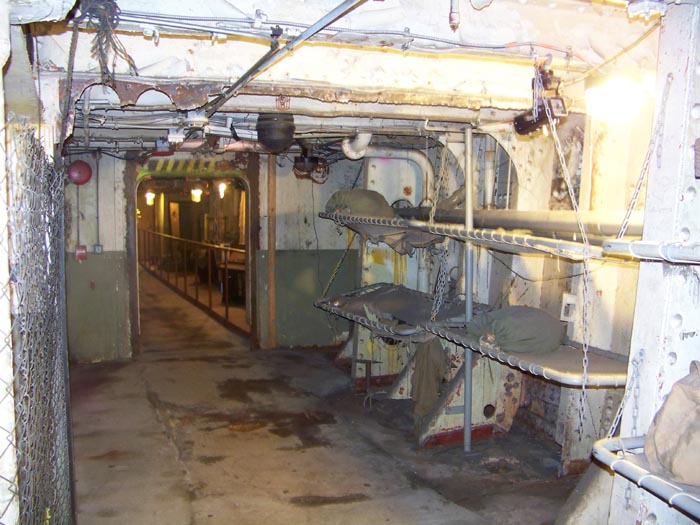
Shipwreck
Exploiting and accelerating the deterioration of the lower decks of the Queen Mary
When the Queen Mary came to Long Beach in 1967 it was purchased with State of California Tideland Funds to house a maritime museum. The five lower decks were almost entirely gutted to house this museum. As noted in the articles on the Working Alleyways and the Power Train, that museum was only partially completed and it only utilized about a third to a half of the gutted space. The museum failed by the 1980s and the space was turned ultimately into an exhibit hall by Disney. The remainder of the lower five decks from Boiler Room 4 forward were left fallow.
In the mid 1990s, the operator of the Queen Mary, the RMS Foundation/QSDI, in an attempt to bring in revenue with little investment in the historic ship started an annual Halloween haunt on the lower decks known as Shipwreck. This operation has continued to the present. Large areas of C, D and E Decks are filled year round with assorted “haunted house” exhibit material used in the mazes that make up the Shipwreck. Fake spider webs, blood, and dead bodies abound.

An area on port side D Deck. During ‘Shipwreck’ the cots have bodies on them but are used like this for the ‘Ghosts & Legends’ tour.
As the years have gone on, Shipwreck has spread to the ship’s museum on D and E Decks as well as the aft engine room. It should be noted that the aft engine room is one of the most popular attractions on the historic ship, but it is closed weeks in advance of Shipwreck in preparation for being decorated with fake dead bodies, spider webs and blood. This is surely a disappointment to a visitor who has traveled thousands of miles to see the real Queen Mary.
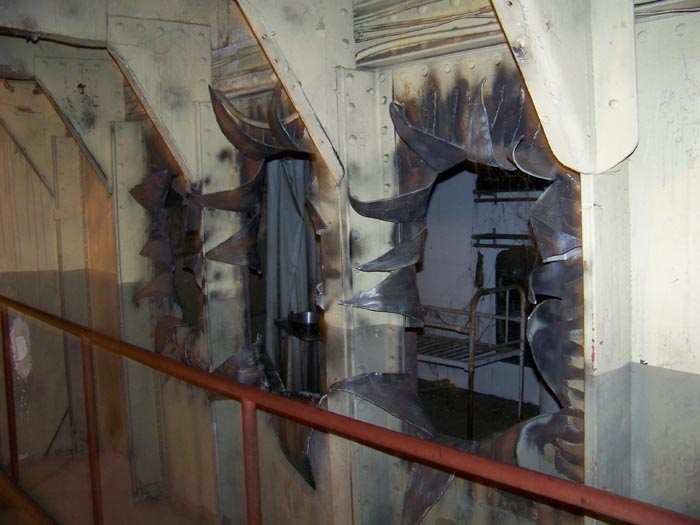
An area of D Deck made to look like a bulkhead exploded. On the other side of this wall is a metal bed and kitchen equipment covered in spider web.
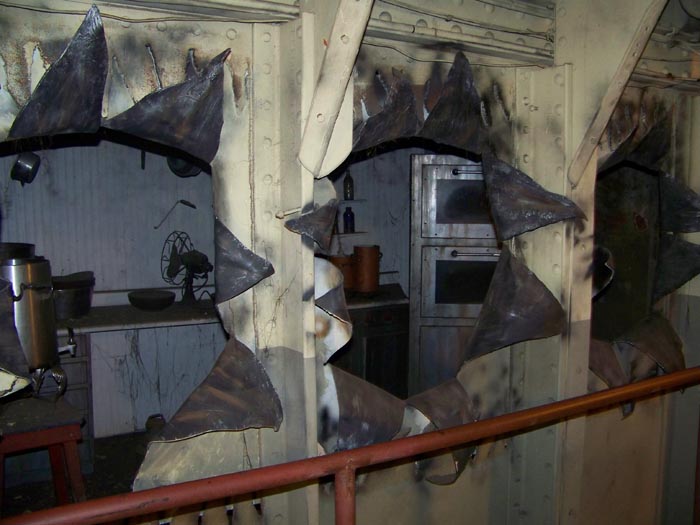
Another view of the area.
Some argue that Shipwreck brings in much needed revenue, but the City of Long Beach has yet to show how the costs for constructing Shipwreck and the profits are distributed between the “for public benefit” foundation and the commercial operation. Is Shipwreck charged for the year-long monopoly on space left fallow for its benefit? How are the many hours of labor spent by foundation employees in building and operating Shipwreck accounted for? How are the alleged many hours of foundation labor spent on building other mazes operated by “Terrorfest Productions” that are not even on the ship or property accounted for? And what has been the result in terms of the ship’s restoration and preservation?
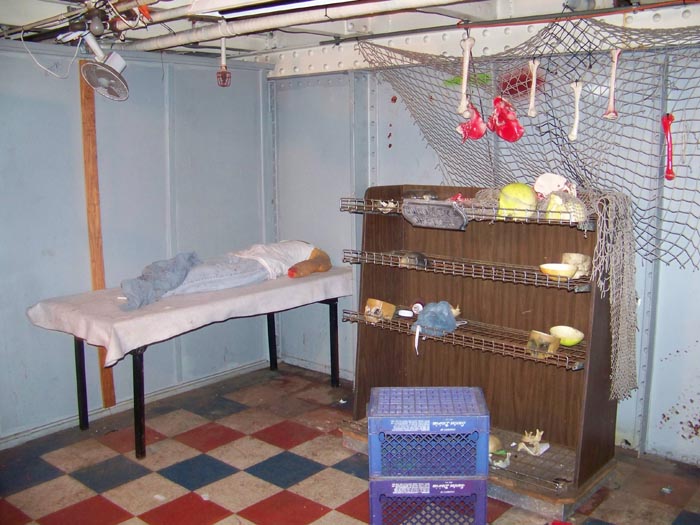
An area on D Deck that clearly shows the effects of ‘Shipwreck’ on the Queen Mary. Important areas of the ship littered with fake bodies, body parts, blood, and spider web.
As the photos illustrate, these areas on C and D Decks are closed off and left in this state all year long for an event that lasts just four weeks. Not only are these areas left with this debris sitting in them year round, but other important areas are filled with discarded furniture that looks like it's been casually tossed around. Some of this is original to the ship while other pieces are from the Long Beach days. In our plan, all original furniture is returned whenever possible (which is most cases) freeing up these makeshift storage areas for restoration and reuse.
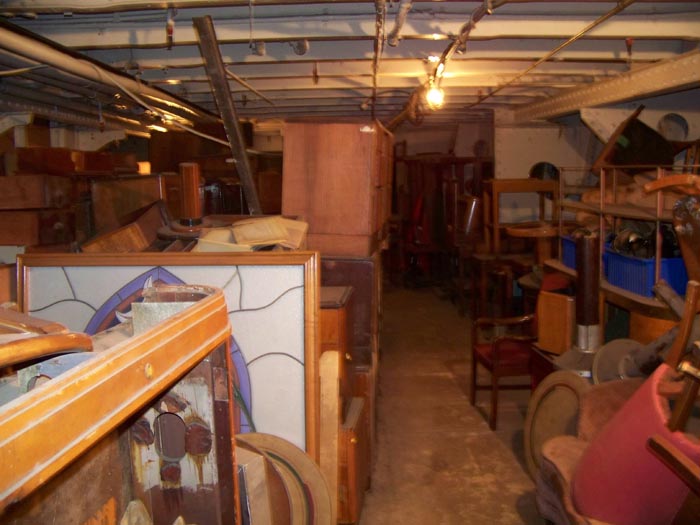
An area of forward C Deck filled with furniture. Some of it appears to be original to the ship.
Perhaps the most important crew recreation space, the Pig & Whistle, is a dumping ground for old Long Beach era furniture while an area adjacent to it is decorated with fake spider webs year round ready to receive Shipwreck guests. The previous lessee has defended the use of these areas in this way claiming to city officials “it is all they’re good for”. This argument makes about as much sense as somebody renting a house, filling the pool with garbage, and telling the landlord “this is all it's good for”.
The major theme parks that host similar events cover more ground and don’t even leave their exhibits in place all year long. The areas are set up a couple weeks in advance of the event and taken down immediately after so that the areas are used all year round for revenue generating purposes. The Queen Mary is not a theme park or at least should not be used as one. It is the last pre-world war ocean liner left afloat and the misuse that the ship has suffered through the theme park approach has only accelerated the deterioration of the lower decks as the photos illustrate.
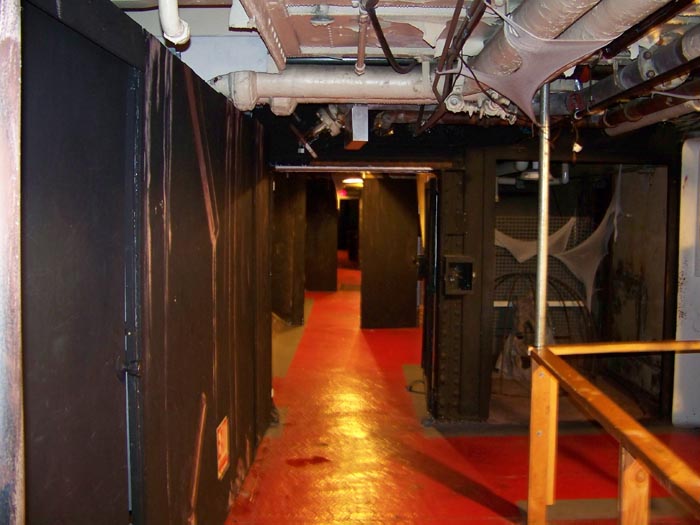
The Working Alley today on C Deck littered by the black partitions that make up the mazes for ‘Shipwreck’.
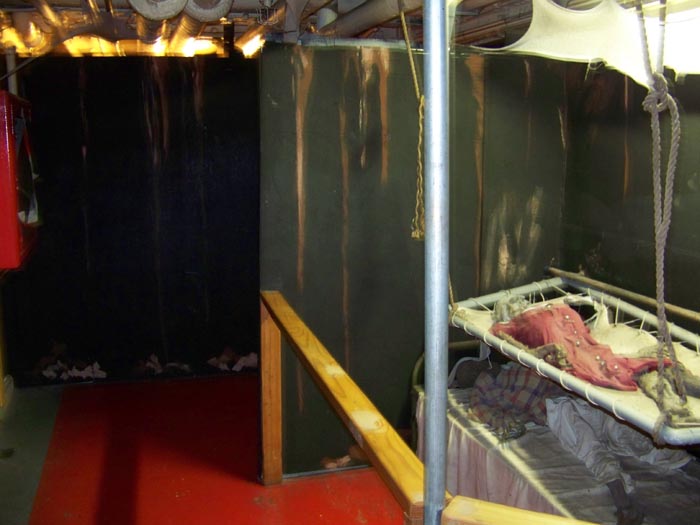
An area of the Working Alley where fake dead bodies are left up during the summer tourist season for an event that is months away. This photograph was taken by the author in June of 2008.
What can be done with these areas to bring in revenue for the other eleven months of the year? If the reviews on sites like tripadvisor.com are anything to go by, people come from all over the world to see the real Queen Mary and are disappointed when they see a ship full of stripped rooms, gutted spaces, tourist trap shops, and low-end carnival smoke-and-mirror acts instead of the luxury liner that they paid to see.
During the summer months the guided tours on the ship are frequently sold out. As of right now the guided tours on the ship cover a very limited area that mostly consists of what’s left of the 1st Class passenger amenities on the upper decks. At present there are virtually no original crew spaces left on the ship for visitors to see (crew cabins, crew working facilities, and crew recreation facilities) other than the bridge and the partially gutted officers’ quarters. What does this mean? Rather than everything below R Deck being used as a dumping ground, we believe that the remainder of the original working alley on C Deck and forward crew spaces should be restored as part of a new guided tour on crew life aboard the historic ship.
This is a relatively simple task. The floor in these areas still bears the ‘scars’ where the original partitions were removed so the original areas are still clearly defined and water tight bulkheads and doors are still in place. The utility pipes that line this deck are housed least intrusively on the ship below D Deck above the fuel tanks. Once those are relocated, this deck is ready to be restored to tell the important story of crew life on the Queen Mary for visitors.
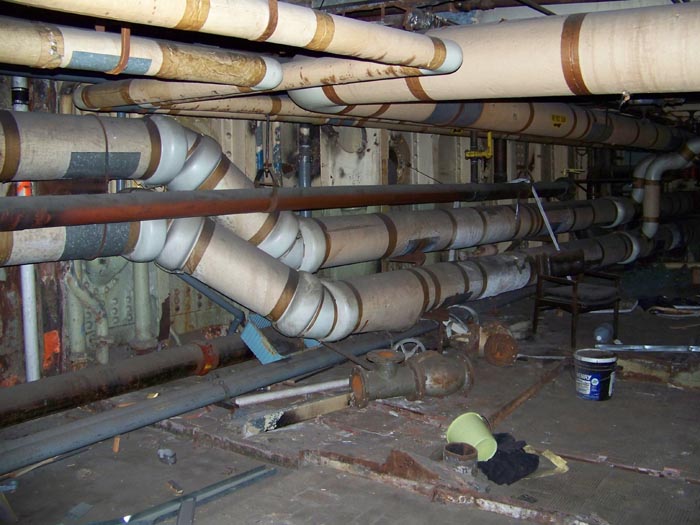
The utility pipes that line C Deck might be housed far less intrusively on the ship below D Deck just above the fuel tanks.

Original Water Tight Door decorated for ‘Shipwreck’. Notice the drink-cans stuffed over the doorway.
With a tour program aboard the ship that covers all of the different facilities that the ship offered in her sailing days (1st, 2nd,and 3rd classes as well as crew spaces) the ship benefits by greatly increased ticket sales for the different tours as well as much more time spent on the ship and property translating into even more revenue through increased food, beverage, and retail sales.
A member of the ship’s current management team recently said to this author, “for some reason people only come to this place once and don’t come back.” With the ship’s deterioration being exploited and marketed as Shipwreck and a floating haunted house, people aren’t given any reason to come back with the exception of locals once a year during Halloween to see Shipwreck. People come from all over the country and the world to the Queen Mary to see a pre-war luxury liner. They are cheated out of that experience by this ‘ghost ship’ image that the ship had forced on it in the early 90s. A program of ongoing restoration of the ship would give people a real reason to come back and see what they paid for.
The continued operation of Shipwreck aboard the Queen Mary symbolizes the failure of the imagination of the operators and the failure of the owner, the City of Long Beach, to accept cultural responsibility for the great maritime asset they purchased. They purchased the ship with the name “Queen Mary”. They didn’t purchase it simply as an unnamed hull. This implies accepting responsibility for the heritage of the ship as well. The ignorance of the press and the indifference of preservation groups both local and broader have allowed this indignity to Queen Mary to go on for far too long. Let’s hope that the new operator, “Save the Queen”, lives up to the name it chose when bidding for this ship. Ending the operation of Shipwreck now would be a good first step towards integrity in the operation.
The
Shipwreck website is at:
http://www.queenmaryshipwreck.com/ (the Shipwreck website is not part of
this site and using this link will open a new window).
![]() Return to Index by Deck
Return to Index by Deck